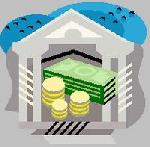
 |
|
| Financial Terms | |
| Keynesianism |
|
Information about financial, finance, business, accounting, payroll, inventory, investment, money, inventory control, stock trading, financial advisor, tax advisor, credit.
Main Page: payroll, money, finance, investment, stock trading, inventory control, inventory, financial advisor, Also see related: first time homebuyer, home buyer, mortgage, home financing, financing, homebuying, buy home, homes, property, |
Definition of Keynesianism
KeynesianismThe school of macroeconomic thought based on the ideas of John Maynard Keynes as published in his 1936 book The General Theory of Employment, Interest, and Money. A Keynesian believes the economy is inherently unstable and requires active government intervention to achieve stability.
Related Terms:Classical MacroeconomicsThe school of macroeconomic thought prior to the rise of keynesianism. MacroeconomicsThe study of the determination of economic aggregates such as total output and the price level. New ClassicalsEconomists who, like classical economists, believe that wages and prices are sufficiently flexible to solve the unemployment problem without help from government policy. fractional interest discountthe combined discounts for lack of control and marketability. g the constant growth rate in cash flows or net income used in the ADF, Gordon model, or present value factor. Absolute priorityRule in bankruptcy proceedings whereby senior creditors are required to be paid in full Accrued interestThe accumulated coupon Interest earned but not yet paid to the seller of a bond by the ActiveA market in which there is much trading.  Active portfolio strategyA strategy that uses available information and forecasting techniques to seek a Agency theoryThe analysis of principal-agent relationships, wherein one person, an agent, acts on behalf of Amortizing interest rate swapSwap in which the principal or national amount rises (falls) as Interest rates Arbitrage Pricing Theory (APT)An alternative model to the capital asset pricing model developed by Asset-based financingMethods of financing in which lenders and equity investors look principally to the At-the-moneyAn option is at-the-Money if the strike price of the option is equal to the market price of the Base interest rateRelated: Benchmark Interest rate. Benchmark interest rateAlso called the base Interest rate, it is the minimum Interest rate investors will Best-interests-of-creditors testThe requirement that a claim holder voting against a plan of reorganization  BookA banker or trader's positions. Bookcash A firm's cash balance as reported in its financial statements. Also called ledger cash. Book profitThe cumulative book income plus any gain or loss on disposition of the assets on termination of the SAT. Book runnerThe managing underwriter for a new issue. The book runner maintains the book of securities sold. Book valueA company's book value is its total assets minus intangible assets and liabilities, such as debt. A Book value per shareThe ratio of stockholder equity to the average number of common shares. book value Book-entry securitiesThe Treasury and federal agencies are moving to a book-entry system in which securities are not represented by engraved pieces of paper but are maintained in computerized records at the Bubble theorySecurity prices sometimes move wildly above their true values. Call money rateAlso called the broker loan rate , the Interest rate that banks charge brokers to finance Capitalized interestInterest that is not immediately expensed, but rather is considered as an asset and is then Cash flow after interest and taxesNet income plus depreciation. Compound interestInterest paid on previously earned Interest as well as on the principal. Country risk GeneralLevel of political and economic uncertainty in a country affecting the value of loans or Covered interest arbitrageA portfolio manager invests dollars in an instrument denominated in a foreign Earnings before interest and taxes (EBIT)A financial measure defined as revenues less cost of goods sold Earnings surprisesPositive or negative differences from the consensus forecast of earnings by institutions Effective annual interest rateAn annual measure of the time value of Money that fully reflects the effects of Equilibrium rate of interestThe Interest rate that clears the market. Also called the market-clearing Interest Forward interest rateInterest rate fixed today on a loan to be made at some future date. General cash offerA public offering made to investors at large. General obligation bondsMunicipal securities secured by the issuer's pledge of its full faith, credit, and General partnerA partner who has unlimited liability for the obligations of the partnership. General partnershipA partnership in which all partners are General partners. Generally Accepted Accounting Principals (GAAP)A technical accounting term that encompasses the Government bondSee: government securities. Government National Mortgage Association (Ginnie Mae)A wholly owned U.S. government corporation Government sponsored enterprisesPrivately owned, publicly chartered entities, such as the Student Loan Government securitiesNegotiable U.S. Treasury securities. Gross interestInterest earned before taxes are deducted. Historical exchange rateAn accounting term that refers to the exchange rate in effect when an asset or Hot moneyMoney that moves across country borders in response to Interest rate differences and that moves InterestThe price paid for borrowing Money. It is expressed as a percentage rate over a period of time and Interest coverage ratioThe ratio of the earnings before Interest and taxes to the annual Interest expense. This Interest coverage testA debt limitation that prohibits the issuance of additional long-term debt if the issuer's Interest equalization taxTax on foreign investment by residents of the U.S. which was abolished in 1974. Interest paymentsContractual debt payments based on the coupon rate of Interest and the principal amount. Interest on interestInterest earned on reinvestment of each Interest payment on Money invested. Interest-only strip (IO)A security based solely on the Interest payments form a pool of mortgages, Treasury Interest rate agreementAn agreement whereby one party, for an upfront premium, agrees to compensate the Interest rate capAlso called an Interest rate ceiling, an Interest rate agreement in which payments are made Interest rate ceilingRelated: Interest rate cap. Interest rate floorAn Interest rate agreement in which payments are made when the reference rate falls Interest rate on debtThe firm's cost of debt capital. Interest rate parity theoremInterest rate differential between two countries is equal to the difference Interest rate riskThe risk that a security's value changes due to a change in Interest rates. For example, a Interest rate swapA binding agreement between counterparties to exchange periodic Interest payments on Interest subsidyA firm's deduction of the Interest payments on its debt from its earnings before it calculates Interest tax shieldThe reduction in income taxes that results from the tax-deductibility of Interest payments. In-the-moneyA put option that has a strike price higher than the underlying futures price, or a call option Limit order bookA record of unexecuted limit orders that is maintained by the specialist. These orders are Limited-tax general obligation bondA General obligation bond that is limited as to revenue sources. Liquidity theory of the term structureA biased expectations Theory that asserts that the implied forward Local expectations theoryA form of the pure expectations Theory which suggests that the returns on bonds Market segmentation theory or preferred habitat theoryA biased expectations Theory that asserts that the Market-book ratioMarket price of a share divided by book value per share. Matched bookA bank runs a matched book when the distribution of maturities of its assets and liabilities are equal. Modern portfolio theoryPrinciples underlying the analysis and evaluation of rational portfolio choices Money baseComposed of currency and coins outside the banking system plus liabilities to the deposit Money banks. Money center banksBanks that raise most of their funds from the domestic and international Money markets, relying less on depositors for funds. Money managementRelated: Investment management. Money managerRelated: Investment manager. Money marketMoney markets are for borrowing and lending Money for three years or less. The securities in Money market demand accountAn account that pays Interest based on short-term Interest rates. Money market fundA mutual fund that invests only in short term securities, such as bankers' acceptances, Money market hedgeThe use of borrowing and lending transactions in foreign currencies to lock in the Money market notesPublicly traded issues that may be collateralized by mortgages and MBSs. Money purchase planA defined benefit contribution plan in which the participant contributes some part and Money rate of returnAnnual Money return as a percentage of asset value. Money supplyM1-A: Currency plus demand deposits Net book valueThe current book value of an asset or liability; that is, its original book value net of any New moneyIn a Treasury auction, the amount by which the par value of the securities offered exceeds that of Nominal interest rateThe Interest rate unadjusted for inflation. Normal backwardation theoryHolds that the futures price will be bid down to a level below the expected Open bookSee: unmatched book. Open interestThe total number of derivative contracts traded that not yet been liquidated either by an Out-of-the-money optionA call option is out-of-the-Money if the strike price is greater than the market price Pooling of interestsAn accounting method for reporting acquisitions accomplished through the use of equity. Precautionary demand (for money)The need to meet unexpected or extraordinary contingencies with a Preferred habitat theoryA biased expectations Theory that believes the term structure reflects the Price/book ratioCompares a stock's market value to the value of total assets less total liabilities (book Pure expectations theoryA Theory that asserts that the forward rates exclusively represent the expected Rate of interestThe rate, as a proportion of the principal, at which Interest is computed. Real interest rateThe rate of Interest excluding the effect of inflation; that is, the rate that is earned in terms Short bookSee: unmatched book. Short interestThis is the total number of shares of a security that investors have borrowed, then sold in the Simple interestInterest calculated only on the initial investment. Related:compound Interest. Speculative demand (for money)The need for cash to take advantage of investment opportunities that may arise. Related to : financial, finance, business, accounting, payroll, inventory, investment, money, inventory control, stock trading, financial advisor, tax advisor, credit. |